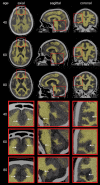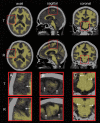The Indigenous South American Tsimane Exhibit Relatively Modest Decrease in Brain Volume With Age Despite High Systemic Inflammation
- PMID: 34038540
- PMCID: PMC8599004
- DOI: 10.1093/gerona/glab138
The Indigenous South American Tsimane Exhibit Relatively Modest Decrease in Brain Volume With Age Despite High Systemic Inflammation
Abstract
Brain atrophy is correlated with risk of cognitive impairment, functional decline, and dementia. Despite a high infectious disease burden, Tsimane forager-horticulturists of Bolivia have the lowest prevalence of coronary atherosclerosis of any studied population and present few cardiovascular disease (CVD) risk factors despite a high burden of infections and therefore inflammation. This study (a) examines the statistical association between brain volume (BV) and age for Tsimane and (b) compares this association to that of 3 industrialized populations in the United States and Europe. This cohort-based panel study enrolled 746 participants aged 40-94 (396 males), from whom computed tomography (CT) head scans were acquired. BV and intracranial volume (ICV) were calculated from automatic head CT segmentations. The linear regression coefficient estimate β^T of the Tsimane (T), describing the relationship between age (predictor) and BV (response, as a percentage of ICV), was calculated for the pooled sample (including both sexes) and for each sex. β^T was compared to the corresponding regression coefficient estimate β^R of samples from the industrialized reference (R) countries. For all comparisons, the null hypothesis β T = β R was rejected both for the combined samples of males and females, as well as separately for each sex. Our results indicate that the Tsimane exhibit a significantly slower decrease in BV with age than populations in the United States and Europe. Such reduced rates of BV decrease, together with a subsistence lifestyle and low CVD risk, may protect brain health despite considerable chronic inflammation related to infectious burden.
Keywords: Brain aging; Cardiovascular disease; Neurodegeneration.
© The Author(s) 2021. Published by Oxford University Press on behalf of The Gerontological Society of America. All rights reserved. For permissions, please e-mail: journals.permissions@oup.com.
Figures



References
Publication types
MeSH terms
Grants and funding
LinkOut - more resources
Full Text Sources
Other Literature Sources
Medical

